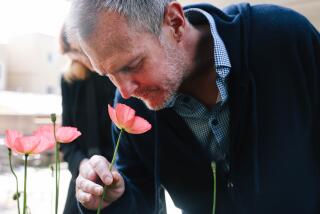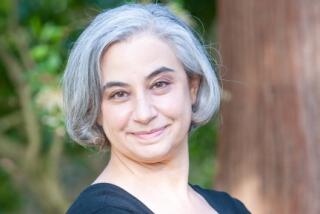Thicker Than Blood : After a Tough Beginning, Couple Is Experiencing Rewards of Adopting 5 Girls
- Share via
SANTA ANA — Minutes after Patty and Fred Duarte signed the legal papers, they bustled their five little girls into Our Lady of the Pillar Roman Catholic Church in a clatter of tiny patent leather shoes and whispers.
The girls pranced down the aisle to say a prayer, a flurry of lacy maroon and gold party dresses, ribbons and brunet curls.
Behind them, Patty Duarte, looking both gleeful and shell-shocked, blurted to an onlooker: “I just adopted four of them today!”
Then, her laughter bubbled over. “Can you believe it?”
On Sept. 26, the Duartes finalized a decision that has more than doubled the size of their family, tripled their monthly grocery bill and quadrupled their weekly consumption of milk to four gallons. And, to haul their burgeoning brood, they have had to buy a mini-van.
The Santa Ana couple adopted four young sisters who had been abused and neglected. They joined the Duartes’ 7-year-old daughter, born heroin-addicted, whom the couple adopted in 1991.
In the process, the Duartes have become poster parents of sorts for an Orange County Social Services Agency deluged with battered, neglected or discarded children. Not only have they taken in five children, they are among the few Latino couples to adopt from the county agency, social workers say.
The Duartes said that many of their Latino friends did not understand why they would want children who were not their own.
“In a lot of Hispanic families, the men are too macho. It has to be blood-related,” said Patty, 35, whose girlfriends left four pink “It’s a Girl” balloons on her doorstep on the day the adoptions were final. “When we told people we were adopting, they said, ‘Oh my gosh, they’re not even blood.’
“Well,” she said, laughing, “We’re thicker than blood. We’re thicker than chocolate cake.”
In fact, their giggling family--Victoria, 8, Tawnie, 7, Jasmine, 6, Rebecca, 4, and Erica, 3--already garners “funny looks” in public, said Fred, 36, a senior analyst with Ralphs Grocery Co. “In the grocery store, a woman said to her friend, ‘Oh look, a typical Mexican family. Look at all those kids.’ ”
Patty laughed. “Like we’re a typical Mexican family.”
More embarrassing, Patty said, was the moment in the market when someone asked why her kids all looked different and the girls helpfully responded: “Because we all have different dads.”
“I was like, ‘No. No. It’s not what you think,” Patty said.
For the Duartes, the decision to adopt came two months after their marriage in 1986, when Patty, then 25, learned she could not have children. It was a devastating blow.
“In Hispanic culture, having children is really important,” said Patty, who, like Fred, is a devout Catholic from a large family. “Not being able to give your husband a child. . . . “
Two weeks later, the Duartes called the county Social Services Agency, only to be told they needed to be married for two years before they could apply to adopt. For the next three years, they tried private adoption, spending $5,000 to support one woman before she miscarried in the second month of pregnancy. A subsequent attempt to adopt a little girl in a Mexican orphanage fell through two days before they were to pick her up.
“I felt like I had to wear a button that said, ‘Unable to Have a Baby,’ ” Patty said. “It was such a heartache for me. . . . I just wanted to forget about it.”
But Fred gently persuaded Patty to try to adopt through the Social Services Agency, even though acquaintances warned them that “all the kids are bad. They’re all drug babies,” Patty said.
At an orientation for people thinking of adopting, the Duartes were the only Latino couple, although a third of the children available for adoption in Orange County are Latino. On their application the Duartes indicated that they would be willing to consider a child born addicted to drugs.
Four months later, in October 1991, the Duartes brought home 2-year-old Tawnie, the child of a heroin and cocaine addict. Tawnie already had had six foster mothers. “She just wrapped her legs around my waist and I knew I was in love. It was the happiest day of my life,” Patty said, her eyes tearing up at the memory. But the next two years were anything but easy.
“She had developed a rage after so many times being moved,” Patty recalled. “She didn’t want to let anyone love her anymore.”
At the county’s recommendation and expense, the Duartes and Tawnie went through $3,000 worth of “rage therapy” with a Lake Forest therapist and a specialist from Colorado, rocking and bottle-feeding Tawnie as if she were a newborn.
At times, Patty and Fred felt that they had stepped into an awful dream. The idea of therapy felt like failure to Fred. “There’s no instruction manual for something like this,” Patty said.
But they both feel the experience has made their bond to Tawnie--today a happy, affectionate first-grader--perhaps stronger than any blood relationship.
“Even now, knowing what we’ve gone through, I wouldn’t trade her for the world,” Fred said.
In late 1994, they were ready to adopt again. This time, Pam Paulson, their social worker, asked if they would be willing to consider adopting a “sibling set.” After the Duartes said yes, Paulson nudged them in the direction of four sisters.
Patty sat down in shock. “When she said four, I was like, ‘What are their ages? Would I even have the energy?’ ”
But Fred thought, “Who’s going to adopt them nowadays? They’ll probably be separated.”
A judge had taken the girls, who each have different fathers, away from their mother 18 months earlier and they had been living in two foster homes.
“I don’t know if it’s fate or what, but these things work out,” Paulson said. “We had someone willing to take one or two of these kids. But [the Duartes] were the only ones willing to take all four.”
Fred said the reality of their decision didn’t hit until the first day they brought the girls home last year for the start of a six-month settling-in period under the supervision of a social worker: “It was total chaos.”
At meals, the girls, who had often gone hungry living with their mother, would keep eating and eating until all the food was gone. Jasmine, then 5, would eat four or five enchiladas. Two-year-old Erica would stuff herself with sandwiches. Patty panicked as the grocery bills mounted.
A nurse friend assured the couple that it was all right to set limits on the girls’ eating.
Victoria, the watchful oldest child, found it hard to relinquish her role as the mother to her sisters and threw bitter tantrums. Jasmine, a fidgety pixie, had behavioral problems.
Patty remembered Fred, normally so calm, saying, “Tomorrow. Tomorrow, you call Pam to come and pick [Victoria] up. I can’t take it anymore.” And Fred remembered Patty replying, “One more week. Just one more week.”
Each hour brought another hair-pulling dilemma: Should she discipline them? How much? And when would she find time to breathe?
There were meetings of Brownies, ballet and Sunday school. PTA, homework and baths. Speech therapy for Tawnie and counseling for Jasmine and Victoria. Tattling and tears. Days started at 6 a.m. and ended when Patty squeezed in snippets of “Unsolved Mysteries” on TV after 11 p.m.
Once or twice a week, a frazzled Patty rang up Paulson for help. “She’d call you up and say, ‘I’m having a real bad day,’ ” Paulson said. “But they just hung in there.”
Some friends from the PTA at Santiago Elementary School, where the girls go to school, took to leaving bags of clothes and toys on the Duartes’ doorstep. Fred’s co-workers threw him a baby shower.
Slowly the problems began working themselves out. The girls stopped fearing that the Duartes would give them away and the haunted look etching their faces smoothed away. The Social Services Agency’s six-month waiting period, after which the parents can legally apply to adopt, passed.
Paulson began sending other flustered parents to Patty for advice and recruited her to deliver orientation talks to families seeking to adopt.
Last Mother’s Day, Patty appeared on a local Spanish-language radio show to talk about her adoption experiences.
“There is so much need for Hispanic families,” Patty said.
More to Read
Sign up for Essential California
The most important California stories and recommendations in your inbox every morning.
You may occasionally receive promotional content from the Los Angeles Times.













